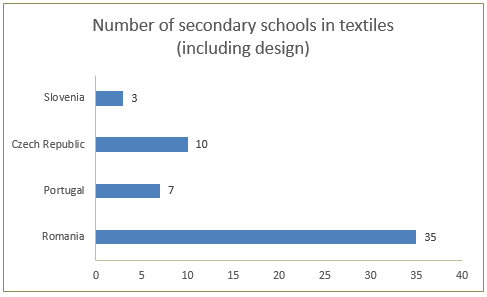Guide for intercultural partnership
In this Guide, we are presenting the Intercultural Partnership developed between the partners of the international ERASMUS+ project E-learning course for innovative textile fields (Advan2Tex). Between the five partner institutions, which come from four different European Union countries (Romania, Portugal, Czech Republic and Slovenia), one can recognize many differences, but also similarities.
6. Analysis of the elements of Intercultural Partnership
6.3. Faculties and secondary schools in partners countries
The differences related to the number of faculties and secondary schools performing the textile and garment engineering programs, including design, are significant.
This was expected, first of all because of the differences in size of the countries and population. These numbers differ also because of the position and shape of the textile-related industries in partner countries.
Number of faculties and secondary schools performing the textile and garment engineering programs, including design, is represented in Figures 5 and 6.

Figure 5: Number of faculties performing the textile and garment engineering programs, including design

Figure 6: Number of secondary schools performing the textile and garment engineering programs, including design
This part of the Intercultural Guide revealed many important differences between the partner countries and institutions. The main differences are related to population and the shape and position of the textile related industries in Romania, Portugal, Czech Republic and Slovenia. Significant are also the differences regarding the number of faculties and secondary schools executing the textile programs.
The export ratios and share of women, working in textile-related industries, are similar in all of participating countries.